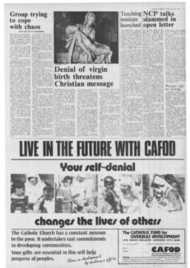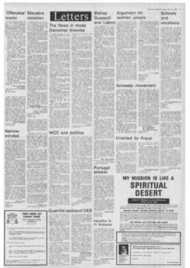Page 6, 18th July 1975
Page 6

Report an error
Noticed an error on this page?If you've noticed an error in this article please click here to report it.
Tags
Share
Related articles
The Monster Can Be Made To Serve
Monstrously Good Fun
There'll Be No Corruption; Says Eammon Andrews
Freda Bruce Lockhart On Films T Wo Small But Exquisite...
Bbc 'like A Drunken Aunt' Muggeridge
TELEVISION
The evidence for and against monsters
THE PAGES of literature are bespattered with' monsters. Monsters fearful and hideous, hydra-headed, mammoth-sized and greeneyed. They exercise a fascination. Who would care about St George if it weren't for the dragon? And even Theseus would have cut a sorrier figure without the Minotaur.
Our hard-bitten age is, of course, agnostic about such phenomena. They are the figments of a disturbed psyche — unless they happen to be pink elephants, in which case we've been imbibing too freely or have got the DTs. But, make jokes as we will, something in us is not quite sure.
In Monsters—Mysteries or Myths? (BBC 2) -the World About Us team examined the evidence for and against our own Loch Ness Monster, the Himalayan Yeti. and the North American Bigfoot. The latter sounds more like a character from a Yogi Bear cartoon than a fearsome unknown monster.
But then, men have always tried to take the sting out of what they most fear by giving it a childish name or an ingratiating one. As, for example, the Greeks called their abhorred Furies the Eumenides,"the gracious ones."
This was a disconcerting programme which pushed and pummelled us into and out of credence. We were just about to be convinced by a piece of filmed "proof." when along came evidence that the "proor' was a fake. Sir Edmund Hilary was one of the sceptics. Proved Yeti relics were, he said, only part of an antelope's skull and the hide of a Tibetan blue bear.
I myself was inclined to believe the witnesses. They seemed earnest, sincere not the kind to make up a story. And why shouldn't they have seen something that other people haven't seen? Do we claim to know everything there is to know about our world? We might be in for another surprise like the coelocanth. One monster at least is fact not fiction. The whale, the largest creature the world has ever known (and that includes the dinosaurs) secured a whole Survival Special to himself (The Passing of Leviathan, Anglia ITV). Beautifully filmed by Des and Jean Bartlett, whose "Flight of the Snow Goose" won two Emmy awards, and narrated by Orson Welles, this Survival film took us to the Valdes Peninsula on the coast of Patagonia. the home of the Southern Right Whale, "a very peculiar-looking animal."
It was not just another natural history film. The open
ing shots showed a blood-red sea as a harpoon shell exploded in a whale's back and another victim fell to man's senseless greed. (Senseless, because there is nothing the whale produces which cannot be produced more plentifully by other means.) Officially, the whale is protected, but there are still II small whaling nations who' refuse to join the International Whaling Commission.
One man who has devoted his life to studying and trying to conserve the species is an American scientist. Dr Roger Payne. His dedication did not begin at college. It began on the day when he found a small whale washed ashore, initials brutally carved on its flanks and a cigar butt in its blowhole. Payne believes firmly that man must cease from greed and learn his place within the natural world. "It is as wrong," he says, "to assume that the earth revolves round man as it was to assume that the sun revolved round the earth." Galileo was denounced as a heretic for denying the latter proposition; but if we don't learn to deny the former, our fate will be even worse.
Antony Thomas is not only a brilliant director; he also has an unerring nose for what is topical. The first film in his new trilogy The Arab Experience (Yorkshire TV) coincided with the death of King Faisal of Saudi Arabia. (It happened to be more or less about him.)
There is no doubt that Thomas is in love with Arabia and Islam, and it is with considerable regret that he signals the old giving way to the new. The old, passive Islam is yielding to a newer, more strident, aggressive and Westernised Arab World; in which boys of eight are trained to become commandos, and Syrian girls march in goosestep.
The modern violence is truthfully recorded, but the camera team of Peter Jackson and Mustapha Hamouri dwells more lovingly on the scenes of peace. The unique scenes of pilgrims approaching Mecca must have been filmed by Hamouri, since no one who is not of Islam may enter the city. Even commercial aircraft carrying Europeans are forbidden to overfly the holy place.
It was intensely moving to see the pilgrims approach the port of Jedda, chanting "0 God, we have come, we have kept our promise." Every Moslem must go to Mecca once in his life. And so they come, from Egypt, from the Sudan, from all parts of the Islamic world, black and white and brown, babes in arms and old men and women almost too old or too disabled to set foot to the ground.
At Jedda they wait days or even weeks for a bus to take them on the last 40 miles of their long journey. With their uncomplaining paticncc, their admirable simplicity and their enviable faith, the pilgrims seemed somehow to be achieving something that the frenetic gun-slingers in the city, whether Moslem or Christian, were not.
blog comments powered by Disqus









